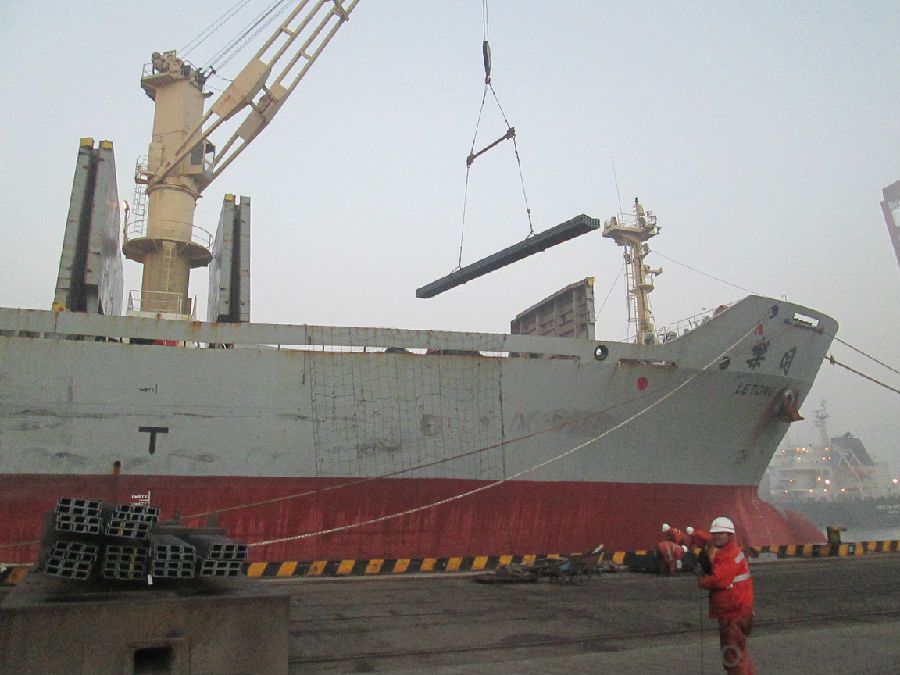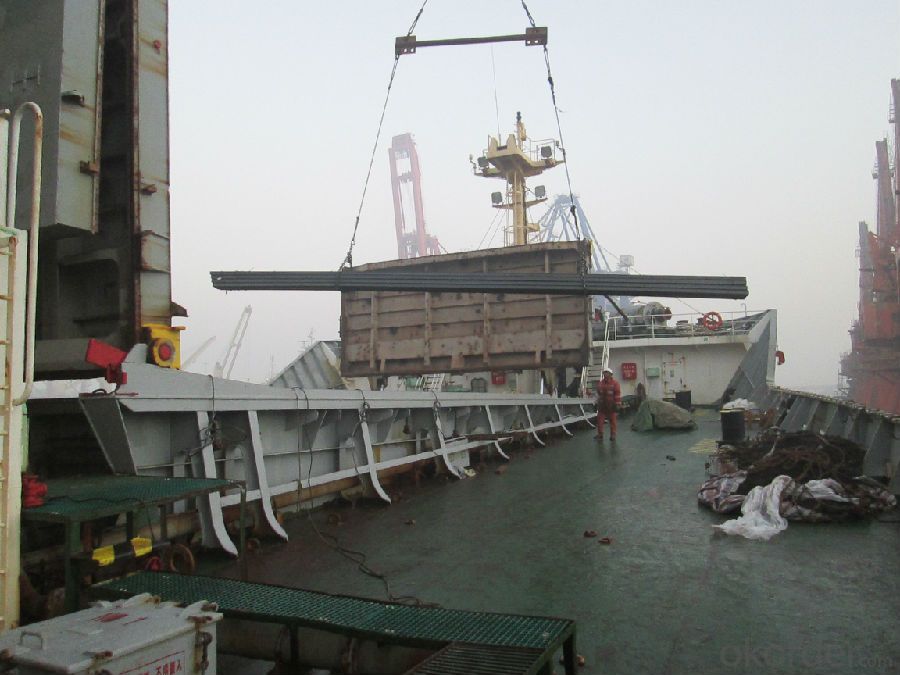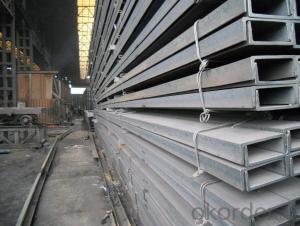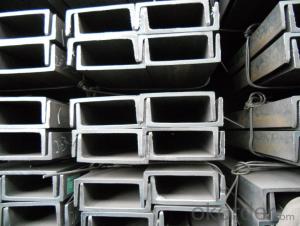U-channel JIS Standard with Different Sizes Hot Rolled
- Loading Port:
- Tianjin
- Payment Terms:
- TT OR LC
- Min Order Qty:
- 25 m.t.
- Supply Capability:
- 2000 m.t./month
OKorder Service Pledge
OKorder Financial Service
You Might Also Like
Product Description:
OKorder is offering U-channel at great prices with worldwide shipping. Our supplier is a world-class manufacturer of steel, with our products utilized the world over. OKorder annually supplies products to European, North American and Asian markets. We provide quotations within 24 hours of receiving an inquiry and guarantee competitive prices.
Product Applications:
1.The JIS channel can be devided into two kinds, namely common channel steel and light channel steel. The sizes of hot rolled common channel steel range from 5# to 40#. Meanwhile, the channel steel can be divided into cold forming sectional equal channel steel, cold forming sectional unequal channel steel, cold forming inner edge channel steel and outer edge channel steel.
2.The JIS channel is usually used for arch-itechtural structure, and they could be welded in order to support or hang a vari-ety of facilities. They are also usually used in combination with I beam. The channel steel with sizes under 14# is usually applied to construction engineering, as purline, while the channel steel with sizes above 16# is more likely to be used in building vehicle chassis structure and mechanical structure. Furthermore, the channel steel in sizes above 30# are target at building bridge structure, as tension bar.
Product Advantages:
OKorder's U-channel are durable, strong, and resist corrosion.
Main Product Features:
· Premium quality
· Prompt delivery & seaworthy packing (30 days after receiving deposit)
· Corrosion resistance
· Can be recycled and reused
· Mill test certification
· Professional Service
· Competitive pricing
Product Specifications:
1.We are able to provide channel steel of top quality at attractive price.
2.Our products of channel steel have passed ISO9001:2008 Quality Management System Certification.
Alloy No | Grade | Element (%) | |||||
C | Mn | S | P | Si | |||
Q235 | B | 0.12—0.20 | 0.3—0.7 | ≤0.045 | ≤0.045 | ≤0.3 | |
Alloy No | Grade | Yielding strength point( Mpa) | |||||
Thickness (mm) | |||||||
≤16 | >16--40 | >40--60 | >60--100 | ||||
≥ | |||||||
Q235 | B | 235 | 225 | 215 | 205 | ||
Alloy No | Grade | Tensile strength (Mpa) | Elongation after fracture (%) | ||||
Thickness (mm) | |||||||
≤16 | >16--40 | >40--60 | >60--100 | ||||
≥ | |||||||
Q235 | B | 375--500 | 26 | 25 | 24 | 23 | |
FAQ:
Q1: How soon can we receive the product after purchase?
A1: Within three days of placing an order, we will begin production. The specific shipping date is dependent upon international and government factors, but is typically 7 to 10 workdays.
Q2: What makes stainless steel stainless?
A2: Stainless steel must contain at least 10.5 % chromium. It is this element that reacts with the oxygen in the air to form a complex chrome-oxide surface layer that is invisible but strong enough to prevent further oxygen from "staining" (rusting) the surface. Higher levels of chromium and the addition of other alloying elements such as nickel and molybdenum enhance this surface layer and improve the corrosion resistance of the stainless material.
Q3: Can stainless steel rust?
A3: Stainless does not "rust" as you think of regular steel rusting with a red oxide on the surface that flakes off. If you see red rust it is probably due to some iron particles that have contaminated the surface of the stainless steel and it is these iron particles that are rusting. Look at the source of the rusting and see if you can remove it from the surface.
Images:


- Q:What are the different methods of insulation for steel channels?
- There are several methods of insulating steel channels, including using insulation materials such as mineral wool or fiberglass, applying spray foam insulation, or using insulated jackets or wraps specifically designed for steel channels. Each method has its own advantages and considerations, depending on factors such as the desired level of insulation, ease of installation, and cost-effectiveness.
- Q:How do steel channels contribute to the overall cost-effectiveness of a wastewater treatment plant?
- There are numerous ways in which steel channels enhance the cost-effectiveness of a wastewater treatment plant. To begin with, steel channels possess exceptional durability and a long lifespan. Consequently, they necessitate minimal maintenance and replacement, resulting in reduced operating costs. By minimizing the need for regular repairs or replacements, the overall maintenance expenses of the plant are lowered. Moreover, steel channels provide outstanding structural strength and stability. They can endure heavy loads and pressures, thereby ensuring the integrity of the wastewater treatment system. This eliminates the requirement for additional reinforcements or supports, lowering construction costs and simplifying the overall design of the plant. Additionally, steel channels offer a high degree of design and installation flexibility. They can be easily customized to meet specific project requirements, enabling efficient utilization of space and resources. This adaptability aids in optimizing the layout of the treatment plant, maximizing its operational efficiency, and reducing construction costs. Furthermore, steel channels exhibit resistance to corrosion and chemical degradation, which is imperative in a wastewater treatment environment. This resistance diminishes the need for frequent replacement or repairs due to corrosion-related issues, resulting in long-term cost savings. Lastly, steel channels are often manufactured using recycled materials, rendering them an environmentally friendly option. By employing recycled steel, the overall production costs are reduced, leading to lower material expenses for the wastewater treatment plant. This not only contributes to the cost-effectiveness of the plant but also promotes sustainability and reduces the carbon footprint associated with its construction. In conclusion, the durability, structural strength, flexibility, corrosion resistance, and use of recycled materials of steel channels all contribute to the overall cost-effectiveness of a wastewater treatment plant. These factors aid in minimizing maintenance and replacement costs, optimizing design and construction, maximizing operational efficiency, and promoting environmental sustainability.
- Q:Can steel channels be used for fencing purposes?
- Yes, steel channels can be used for fencing purposes. Steel channels provide strength and durability, making them suitable for constructing sturdy fences. They can be used to create a robust framework for various types of fencing, including chain-link fences, wire mesh fences, and even privacy fences.
- Q:18# channel perimeter
- Channel 18#A 180*68*7.0 theory weight 20.174, section area 25.69, channel 18#B 180*70*9.0 theory weight 23, section area 29.29, average leg thickness 10.5, inner arc radius 10.5, leg end arc radius 5.25
- Q:Can steel channels be used in DIY projects?
- Yes, steel channels can be used in DIY projects. Steel channels are versatile and can be utilized in a variety of applications such as constructing frames, supports, shelving, and even furniture. They are strong, durable, and can provide structural stability to your DIY projects. Additionally, steel channels are available in various sizes and shapes, allowing you to find the perfect fit for your specific project requirements. Whether you are working on a small-scale DIY project or a larger construction undertaking, steel channels can be a valuable addition to your arsenal of materials.
- Q:How do steel channels contribute to building envelope performance?
- Steel channels contribute to building envelope performance in several ways. Firstly, they provide structural support, adding stability and strength to the overall structure. This is crucial for withstanding external forces such as wind, snow, and earthquakes. Secondly, steel channels can act as a framework for insulation materials, helping to improve the building's thermal performance by reducing heat transfer. Additionally, they can be used to create air barriers, preventing unwanted air infiltration and enhancing energy efficiency. Finally, steel channels can also support the installation of windows and doors, ensuring proper sealing and weather resistance. Overall, steel channels play a vital role in enhancing the performance and durability of the building envelope.
- Q:Are steel channels suitable for use in corrosive environments?
- No, steel channels are not suitable for use in corrosive environments as they are prone to rust and corrosion.
- Q:What does channel C10 mean? What is the full name of C?
- Decent channel steel, with two thicker legs, does not curl (it rolls too tightly). Used for stressed structures.
- Q:What are the factors to consider when selecting the right type of steel channel?
- When selecting the right type of steel channel, several factors need to be considered. These include the required load-bearing capacity, the intended application or industry, the desired level of corrosion resistance, the environmental conditions, the length and size requirements, and the budget. Additionally, factors such as the availability and ease of installation should also be taken into account.
- Q:What are the different standards for steel channels?
- There are several different standards for steel channels, which are used to specify the dimensions, mechanical properties, and other characteristics of these structural components. Some of the most commonly used standards include: 1. ASTM A36: This is the most widely used standard for steel channels in the United States. It specifies the chemical composition, mechanical properties, and dimensional tolerances for carbon steel channels. 2. EN 10025: This European standard covers structural steel channels made from hot-rolled non-alloy and fine grain steels. It provides requirements for the chemical composition, mechanical properties, and delivery conditions of these channels. 3. JIS G3192: This Japanese industrial standard specifies the dimensions, mass, and tolerances for hot-rolled steel channels. It also includes requirements for the shape, appearance, and surface quality of these channels. 4. AS/NZS 3679.1: This Australian/New Zealand standard covers hot-rolled structural steel channels. It provides requirements for the chemical composition, mechanical properties, and dimensions of these channels. 5. GB/T 706-2008: This Chinese standard specifies the dimensions, shape, weight, and tolerances for hot-rolled channel steel. It also includes requirements for the technical requirements, test methods, and inspection rules for these channels. These standards ensure that steel channels meet certain quality and performance criteria, allowing them to be used safely and effectively in various construction and engineering applications. It is important to refer to the appropriate standard when selecting steel channels to ensure compliance with the required specifications.
1. Manufacturer Overview |
|
|---|---|
| Location | |
| Year Established | |
| Annual Output Value | |
| Main Markets | |
| Company Certifications | |
2. Manufacturer Certificates |
|
|---|---|
| a) Certification Name | |
| Range | |
| Reference | |
| Validity Period | |
3. Manufacturer Capability |
|
|---|---|
| a)Trade Capacity | |
| Nearest Port | |
| Export Percentage | |
| No.of Employees in Trade Department | |
| Language Spoken: | |
| b)Factory Information | |
| Factory Size: | |
| No. of Production Lines | |
| Contract Manufacturing | |
| Product Price Range | |
Send your message to us
U-channel JIS Standard with Different Sizes Hot Rolled
- Loading Port:
- Tianjin
- Payment Terms:
- TT OR LC
- Min Order Qty:
- 25 m.t.
- Supply Capability:
- 2000 m.t./month
OKorder Service Pledge
OKorder Financial Service
Similar products
New products
Hot products
Hot Searches
Related keywords


























